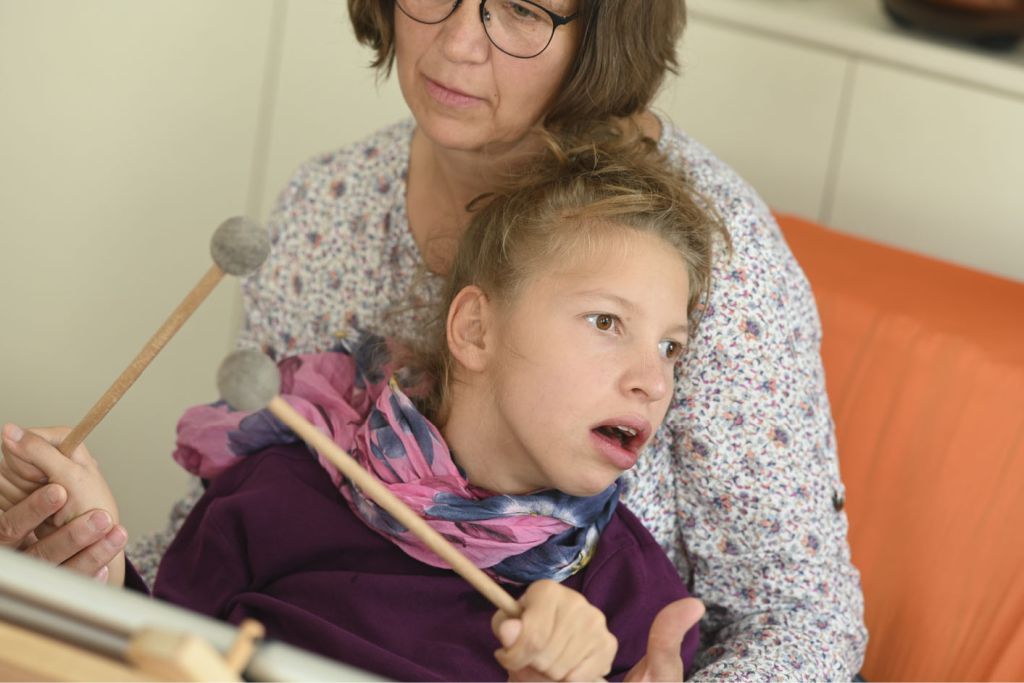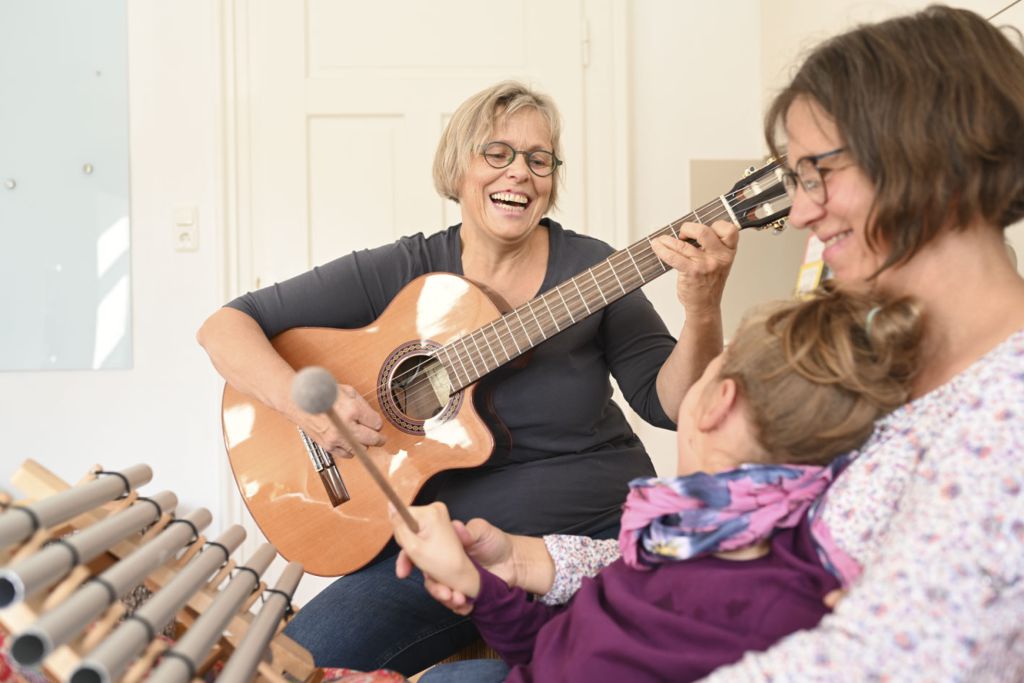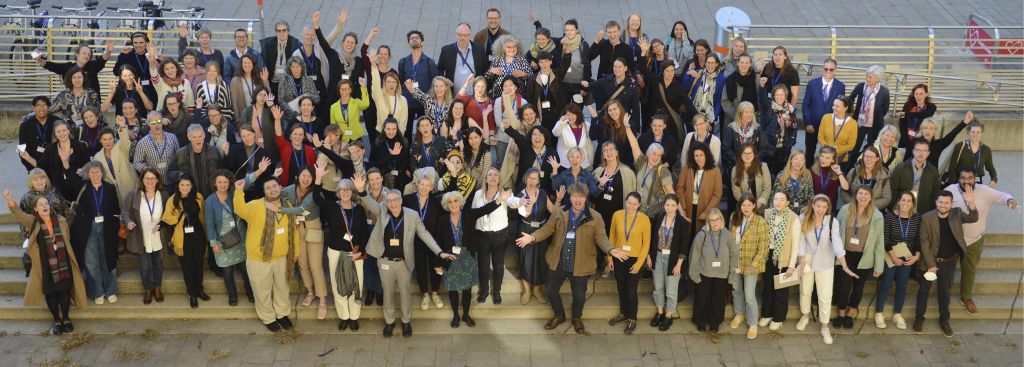“I was trapped inside myself for a long time. And I was all alone with myself, locked [up], and nobody had access to where I was. Sometimes, I was very afraid that the door would never be found…
“It’s like music can be a gateway through which I can see into other worlds. I’m light as a feather and can leave my stubborn body behind. I dance on a soft cloud. I can feel completely free and at ease.”

This is how 15-year-old Lilly Haller describes her experiences prior to and after the beginning of her music therapy treatments in 2019, for which she and her mother participated in a research project pursued by the German music therapist Brigitte Meier-Sprinz and the neuropediatrician Andreas Sprinz (Kempten, Allgäu). These two experts were investigating how mobile music therapy offerings in rural areas might help children with serious brain damage as well as their families.
Lilly Haller was born in 2007. Though the pregnancy had been inconspicuous, her birth was accompanied by serious complications that she barely survived. After numerous stays in intensive care units and at rehabilitation clinics, she was left with serious acquired brain damage that exhibited characteristics of dyskinetic/spastic cerebral palsy combined with structural focal epilepsy. Lilly sat in a wheelchair, barely able to control her movements and unable to communicate by speaking. She proceeded to grow up on a large farm as part of a very loving family.
“I still remember the beginning of music therapy. I was curious and cautious. I didn’t know what was in store for me or what was being done there. It was good that my Mum was there. It was often the case that I had to hear what I can’t do and will never learn. That’s why I’m rather cautious when someone wants to do something with me.”
Music therapy is a scientific, artistic, creative, and expression-facilitative form of therapy that has been legally regulated in Austria as an independent health profession since 2009. And with its Department of Music Therapy, led by Thomas Stegemann, the mdw is home to Europe’s oldest academic music therapy programme, which has been training music therapists since 1959. It has also been possible to pursue doctoral studies in music therapy here since 2013, and the past five years have seen the creation of a new research structure institutionally anchored as the Music Therapy Research Centre Vienna (WZMF). One of the WZMF’s areas of focus is music therapy work with children and youth—with special attention paid to the involvement of attachment figures in the music therapy setting.
Music therapists receive specialised training in the employment of music or its various components for therapeutic purposes, enabling them to reach people via a preverbal pathway. Increasingly, music therapy is being provided as part of therapeutic relationships. By means of melody, rhythm, and sound, even minimal instances of contact can be rendered audible, and it becomes possible to express and/or share feelings.
“I’d never seen so many instruments in one room at once. I was allowed to touch everything and hear how it sounded. It was such that we had to get to know each other first. Very carefully, but thoroughly. At that time, I was still [..] often sick and really frustrated because I was so misjudged. I was afraid that it would be the same in music.”
Lilly and her mother took part in music therapy offerings over the course of several months and began making music at home, as well. Over the course of these sessions, it became clear that Lilly was able to move a muscle in her upper arm in a way that was not permanently overlaid with spasticity and dystonia. Her mother supported and reinforced these minimal motions. Lilly then began repeating certain rhythmic patterns, and she also practiced these controlled motions in her occupational therapy sessions. The door to communication—and hence to active participation in life— to open. It turned out that Lilly was already capable of using letters as well as able to read, meaning that she had a command of language and writing.

“If you can’t talk about it all, you’re locked away lonely with fear and joy. If one is alone and nobody finds the door, then one has to be very careful, because the soul becomes more and more fragile and would eventually break completely and nobody would notice. Since the soul can only be seen with the whole heart.”
With help from her mother, Lilly began expressing herself using colourful letter-cards and then via digitally supported communication methods. She’s since gone on to write impressive texts about her experiences and is now aiming to someday become an author.
The Symposium “Music Therapy with Families”
In September 2022, Lilly Haller appeared in Vienna as a lecturer at the mdw symposium Music Therapy with Families together with her music therapist Brigitte Meier-Sprinz and her neuropediatrician Andreas Sprinz. She describes her impressions from this experience as follows:
“I had time to look into the faces of those in audience. They were very attentive. I enjoyed this time onstage a lot, because I was finally able to tell the world something important. I felt a joy spreading out within me. It was a magnificent feeling.”
Music Therapy with Families, organised by Eva Phan Quoc, Agnes Burghardt-Distl, and Thomas Stegemann, took place at the mdw from 23 to 25 September 2022 as the first international symposium devoted specifically to music therapy work that involves clients’ families, partners, and attachment figures. It saw over 180 participants (live and online) from 30 countries deal with an extraordinarily wide variety of methodological approaches in various fields of work.

Discussions revolved around central themes such as the diversity to be found in the broad range of definitions of the term “family” in different cultures (supported by the platform Gender_mdw), the significance of interdisciplinary collaboration, and above all the necessity of even more diligent and permanent reflection on one’s own attitude as a therapist in complex systems. Particularly impressive were the joint presentations by former patients and clients, who appeared together with their reference persons and music therapists to shed light on their personal experiences from the most varied perspectives.
As a concluding message, Lilly Haller encouraged those present to question their own snap categorisations: “It’s so important that we pay attention to each other; everyone is so unique. It’s not particularly wise to cubbyhole children, because it robs those thus categorised of their zest for life.”

